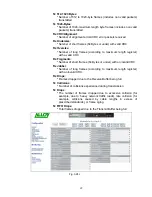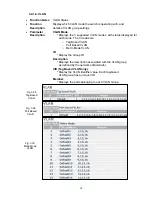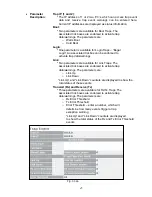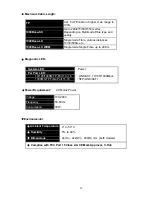
49
4.
Maintenance and Basic Troubleshooting
New generation switches are in most respects a ‘black box’ solution in terms of the basic
installation and connection of network nodes (workstations, servers, subsidiary switches etc).
Many discrete components that were present in earlier generation switches have now been
‘folded’ into the ASIC chipset of modern switches. Factors such as these have greatly
enhanced the ease of use, reliability and maintenance of these devices.
This section is not intended to be a comprehensive overview of all maintenance and
troubleshooting issues (especially the latter area); here we concentrate on some basic yet
important issues that should be kept in mind when installing and using your Alloy switch.
4.1. Maintenance - Environment
Standard switches such as the Alloy 16/24 port Gigabit models are designed for use in an
office environment. Specialised switches are available that are designed for use in adverse
environments, such as manufacturing facilities, where dust, heat, vibration and other factors
are an issue. If a standard type switch must be used in such an environment, it should be
installed in an environmentally secure enclosure. For use in office environments, the
following maintenance issues should be kept in mind:
z
Airflow
: as with all electronic devices, a switch produces heat. Inadequate or obstructed
airflow around the switch can lead to heat buildup and damage to components. Ensure
that adequate clearance is maintained around any ventilation points on the switch case
z
Dust/airborne particles
: As mentioned
above, standard switches should not be used in
a dusty environment, or if used, precaution should be taken to eliminate the ingress of
particles into the switch through the ventilation points (environmentally secured cabinets
etc). Dust will still be present in a normal office environment, so consideration should be
given to using dustcaps to cover RJ-45 and Fibre ports that are not in use – particularly if
a port is not used over an extended time frame. This is particularly important for fibre
optic ports, and devices such as mini-GBIC modules which are usually supplied with
dustcaps.
4.2 Maintenance – Switch Components/Attachments
As mentioned above, modern switches have far fewer components than earlier generation
switches. There are no internal parts in an Alloy switch that require user
maintenance/intervention (it should be remembered that Alloy’s warranty terms exclude
customer intervention inside the switch case, which should not be opened by anyone other
than Alloy or an appointed alloy agent. Alloy’s Warranty Terms can be viewed on the
company web site at this address: http://www.alloy.com.au/warranty.asp. The following items
should be kept in mind:
z
Fans
: Alloy 16/24 Port Gigabit Switches use a fan to ensure good levels of airflow in the
switch case. The fan does not need maintenance. As the only moving part in the switch,
this is the only possible source of mechanical noise inside the switch. Contact your Alloy
reseller or the Alloy Service Department direct if any unexplained mechanical noise is
heard from within the switch.
•
Network Cables
: If cables are regularly disconnected from ports and then re-connected,
periodically inspect the cable connectors to ensure that wear or misuse has not
impaired the ability of the connector to be firmly seated in/on the port and locked in place
(for example, the plastic locking clip on RJ-45 connectors)
•
AC Mains Power Cord
: Periodically inspect the power inlet point on the switch to ensure
Содержание 16-PORT GIGABIT WEB SMART SWITCH GSS-16T2SFP
Страница 2: ...ii June 24th 20005...
Страница 6: ......






































